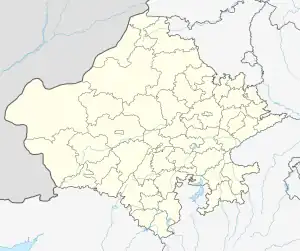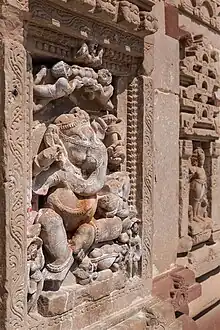| Sachiya Mata Temple | |
|---|---|
 Sachiya Mata Temple, Osian | |
| Religion | |
| Affiliation | Hinduism |
| Deity | Indrani |
| Location | |
| Location | Osian, near Jodhpur, Rajasthan, India |
| State | Rajasthan |
| Country | India |
 Location in Rajasthan  Sachiya Mata Temple (India) | |
| Geographic coordinates | 26°54′14″N 72°48′59″E / 26.9038°N 72.8165°E |
| Architecture | |
| Creator | Gurjara Pratihara period |
The Sachchiya Mata Temple is a Hindu temple located in Osian, near Jodhpur city in the Indian state of Rajasthan.
The mother Hindu goddess Sachiya (also spelled as Sachayay Mata and Sachchiyay Mata, Hindi: सच्चियाय माता/सच्चिया माता) is worshipped by many castes and communities living in Rajasthan, Gujarat, Madhya Pradesh and North India.This temple was built during the Gurjara pratihara period .[1]
Maa Jagat Bhawani Shri Sachchiyay Mataji was historically called Shri Osiya Mataji.
An archaeological team found many samples, statues, and paintings there. Depictions included the ancient deity of Harihar (half Shiva and half Vishnu), Vasudeva with baby Krishna on his head, Krishna fighting with a horse, the killing of Putna, Kalidaman, Govardhan dharan, and butter stealing along with images of Balram which seem to represent him as the incarnation of Seshnaga.
Osiya was once a large town. Telivada was situated 3 miles (4.8 km) away in Tinvari village. Pandit ji ki Dhani (now the small village of Pandit pur) is 6 miles (9.7 km) away. A further 6 miles (9.7 km) away is Kshatripura. At 24 miles (39 km) is Lohavat, home of iron smiths. 108 temples were found in Osiya.
Osiya is situated about 37 miles (60 km) from Jodhpur, Rajasthan. It is connected by roads and trains with Jodhpur and Pokharan.
Legend


Goddess Sachi was a daughter of the Asura king Pauloma. The benevolent King Pauloma ruled a great kingdom, sponsoring many Brahmins (for example, Shukracharya). Vrut (Vritra) was the chief of Pauloma's army, and he wanted to marry Sachi. However, Sachi considered this proposal insulting, as she did not want to marry a servant of her father. Knowing the thoughts of Sachi, Vrut left the service of Pauloma and worshipped Lord Shiva, a common god of the Asuras. Shiva gave Vrut his blessings, and the boon that he could not be killed by any known weapons. Vrut, with his magic, assembled a great army, and with this virtue of immortality, he set out to win the Aryan lands and carve out a kingdom greater than Pauloma's.
It was the duty of Indra, the king of the gods, to defend the kingdom from Vrut. Knowing that Vrut had the blessing of immortality, Indra approached Sage Dadhichi, for Dadhichi had bones tougher than any known weapon. Dadhichi gave his bones to Indra, by performing a self-sacrifice, and Indra prepared a weapon, known as Vajra, from these bones. (The highest award of bravery in India, the Param Vir Chakra, bears the symbol of Vajra.) Since bones had never before been used for a weapon, this defied the condition of immortality for Vrut.
The armies met on the battlefield, but Indra proposed that instead of allowing the full forces to fight, resulting in huge carnage, he and Vrut alone should fight; the victor would take over the other's army and would marry Sachi. Indra emerged from this challenge victorious.
Panels of Dieties

_sachiya_Mata_temple%252C_8th-10th_cent._%252C_Pratihara_dynasty.jpg.webp)
See also
References
- ↑ Chaitanya, Krishna (1987). Arts of India.
External links
- Pictures of Sachiya Mata Temple, Osian
- Sachiya Mata Temple, Jodhpur
- Shri Sachchiyay Mataji Temple, Sardarshahar
- Information on Shri Sachchiyay Mataji (Shri Osiya Mataji) Temple
- shriosiyamataji.org
- http://www.missionkuldevi.in/2015/07/sachchiyay-mata-temple-osiyan-rajasthan-html/
- http://www.missionkuldevi.in/2016/12/sachiya-mata-katha-mahatmya-shlok-itihas-hindi/